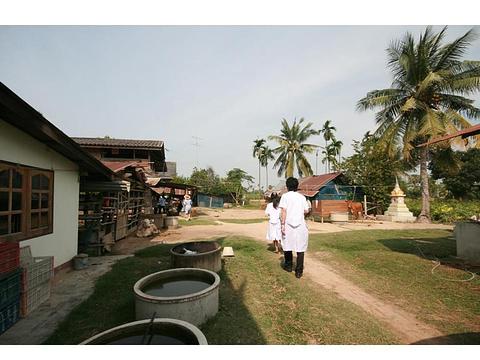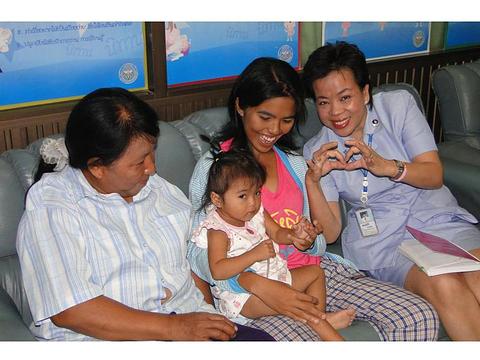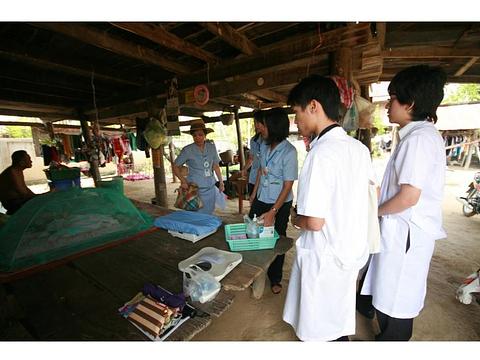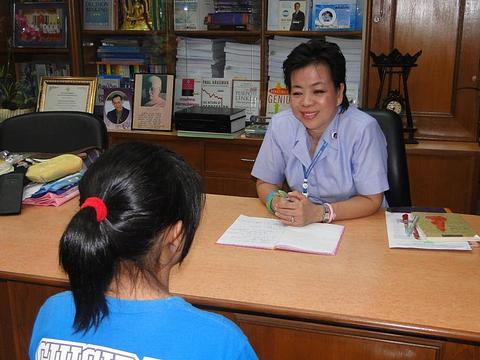"1D4S for Teen Moms Care"..การดูแลด้วยหัวใจ...ของความเป็นมนุษย์?
SHA คือ..ความสุข...ในการทำงาน ... เราทำงาน .. "ด้วยใจ" ...เราทำงาน.. "ด้วยความสุข" .... สิ่งที่เรามอบให้คนอื่นนั้นก็..คือ ... ความสุข ...ที่พวกเขา/คนไข้...จะได้รับ ... ซึ่งคำตอบและมองได้จาก... "รอยยิ้ม" .... ที่หมอเปิ้นได้รับจาก... "แม่วัยใส" ... เมื่อได้ลงไป ... เยี่ยมบ้านพวกเธอ และ ไปดูแล/พูดคุยกับเธอ...ที่บ้าน (Home Visit & Home Help Care) ... อยู่เสมอๆๆ มาค่ะ .... พวกเธอบอกว่า ... หมอเปิ้น....ได้ช่วย...."บรรเทาความทุกข์".... ของเธอ ... ได้...ช่วยลดแรงปะทะ และ แรงกดดัน....จาก..ครอบครัว... จาก...คนในชุมชน และ จากโรงเรียน .... นะคะ ... คำตอบนี้ ...วัดได้จาก ... "รอยยิ้ม และ น้ำตา" .... ของพวกเธอค่ะ

ออกไป...เยี่ยมบ้าน ... รถเข้าไปไม่ถึงค่ะ..... เราต้องเดินเข้าไป.... เดินไปหา...พวกเธอ...ไปกันนะคะ (ซึ่ง.. "ใจเป็นนาย"... กายเป็นบ่าว นะคะ)


เราเข้าไป...ไปติดตาม..หลายๆเรื่องค่ะ... การเลี้ยงลูกด้วยนมแม่... ติดตามด้านจิตใจและอารมณ์ (Mind & Emotion)
"Innovative depression prevention in Thai adolescent mothers during pregnancy."
Somsri Nawarat
Banlad Hospital
Petchaburi Province, Thailand,





IV. results ==> "Innovative depression
prevention in Thai adolescent mothers during pregnancy"
The research findings are reported as follows. First, this research study suggested the model called “Teen Moms Care Model” which consisted of “1D4S”
(Depression, Somatic and medical support, Social support, Self-esteem and
Stress). Second, the structural equation model of the variables affecting
the depression in pregnant Thai adolescents as per the hypotheses or conceptual
framework of the study corresponded with the empirical data. The researcher
adjusted the model six times. The results of testing statistical data of the
adjusted structural equation model and the standard criteria suggested by Joreskog&
Sorbom
(1996) reported that all of the
statistical data of the model passed the standard criterias: Relative χ2(χ2/ df)= 1.61, Goodness of Fit Index(GFI)= 0.96, Adjusted Goodness of Fit Index(AGFI)= 0.94, Root Mean Squared
Residuals (RMR) = 0.023, Standardized Root
Mean Squared Residual(SRMR)=
0.042,Root Mean Squared Error of Approximation(RMSEA)=
0.038, p-value for test
of close fit= 0.94, Normed
Fit Index (NFI)=0.98, Incremental Fit Index
(IFI)= 0.99, Comparative Fit Index(CFI)=
0.99, Critical N (CN)=295.80.
However, the findings suggested thatLikelihoodRatio
Chi-SquareStatistic(c2)is
still statistically significant because it is sensitive to multivariate
normality. If the sample size is small, the tested statistical data
distribution is always not close to c2standard distribution. In contrast, if the sample size is
too big, the df model is always rejected. Therefore, theLikelihoodRatio Chi-SquareStatistic(c2) remains problematic. The estimation of model in this
research used Relativec2(c2/df)instead.
The findings from the study the direct effect, indirect
effect and total effect of the variables affecting depression in
418 Thai adolescent mothers during pregnancy showed that somatic and medical support had a positive direct effect
and a negative indirect effect towards depression with the coefficient of 0.16
and -0.14 respectively but had no overall effect. Self-esteem had no direct
effect but had an indirect and negative overall effect with the coefficient of
0.31 and -0.47. Social support had no direct effect but had an indirect effect
and negative overall effect with the coefficient of -0.30 and -0.27. Stress had
a positive direct effect and positive overall effect towards depression at the
effected coefficient of 0.84 but had no indirect effect at the statistical
significance of 0.05as per Figure 7 and Table 1.
TABLE 1: THE ANALYSIS OF PARAMETER, DIRECT,
INDIRECT, TOTAL EFFECTED COEFIFICIENTS

*
means the statistical significance at 0.05

FIGURE 5 THE STRUCTURAL EQUATION MODEL OF THE VARIABLES AFFECTING THE DEPRESSION (ADJUSTED MODEL)

According to Figure 3,the structural equation model of the variables affecting the depression in pregnant Thai adolescents in Phetchaburi province depicts the model called “Teen Moms Care Model” which consists of “1D4S” (Depression, Somatic and Medical Support, Social Support, Self-Esteem and Stress). Meanwhile, the in-depth analysis of qualitative research with the variable of somatic and medical support report that the pregnant adolescents have food consumption misbehavior and malnutrition. They eat what they like, for example, they do not like drinking milk but soft drinks. They prefer pickled fruits and vegetables to the fresh ones. This results in the risk of under-weighted and pallid children. The negligence of taking care of their health and the suggestions of doctors on taking iron and iodine supplements, rejecting food necessary for increasing blood concentration, and rejecting sea food to supplement iodine lead to lacks of iodine and disease protection. Furthermore, the problem of Rh negative blood group also found in 2 subjects while 99% of Thai people have Rh positive, and two adolescent mothers who carried twins must have caesarean section. The heights of 3 adolescent mothers do not reach 150 cm. which represents prematurity. The youngest adolescent mothers found aged only 12 years old. For the self-esteem variable, during the in-depth interview, the researcher found that the pregnant adolescents felt that they were wrong and misbehave because they were pregnant while they were students. More than half of the samples said that they were studying in secondary school and high school. Their self-esteem level was lower because they had to quit school, they felt that they were useless, ashamed to friends, teachers, local people, had negative self-perception, unsatisfied with their pregnancy, made their parents upset, ashamed and lack of social acceptance. They had to change their roles from students to mothers when they did not want to be, and they had negative self-perception. Eight adolescent mothers were not accepted by their husbands. Eleven adolescent mothers did not know before that they became the second or third wives. Some of them took the abortion pills. When they found that they did not have menstruation, they were sure that they were pregnant then they had very high stress. They did not receive good care from their husbands even giving money for taking care of the children, asking them how they had been, or boosting their spirits. Most of them were supported by the society and most of the helps came from their mothers and grandmothers in terms of accommodation, comforting, caring, and taking them to the hospitals for checking as per the doctors’ appointments.
For the stress variable, the findings report that when the adolescents know that they are pregnant, they have very high stress. They cannot sleep well, worried, unhappy, and afraid of misconduct. They are scared to tell anyone and want to die especially when they know that they become the second or third wives. They lack concentration, some of them escaped from their families, schools, and have headaches. Some of them conceal the pregnancy for 5 months and their husbands do not accept the responsibility to become a father of the baby. They feel very unhappy and hide from their parents, schools, friends which lead to depression. When they know that they are pregnant, they do not want to talk to anyone, feel bored, upset, and unhappy, feel lonely, cry every night, cannot sleep well, and have nightmares. They would like to be by themselves, do not want to meet anyone and escape from their families. They are afraid of being gossiped and scared of the delivery process. They want to die and think about committing suicide. The depression caused by accumulated stress cannot be solved, they are unhappy both physically and mentally, they are too ashamed to meet anyone, and they cannot earn their living. Their husbands are also students and they still have to ask their parents for money. Therefore, the pregnant adolescent mothers have many problems on somatic and medical support, self-esteem, and social supportwhich lead to stressand depression.
In general, the finding of the structural equation model of the variables affecting the depression in pregnant Thai adolescents in Phetchaburi province suggested the model called ....“Teen Moms Care Model” which consisted of “1D4S” such as somatic and medical support variable with the factors consisting of health behavior, risk, disease, drug and vaccine.
The findings in this study correspond with those previous studies. In terms of risk, the pregnant adolescents younger than 17 years old have anemia, malnutrition, late and incomplete Ante Natal Care, urinary tract infection, the size of the babies are not appropriate for the pelvic bones, and miscarriages caused by self-abortion (Ukrit Uchupap, 2010; Bunpode Suwannachatand Prapatsorn Ualalitchoowong,2007). The pregnant adolescents aged 13-17 years old face with the height and weight lower than standard, abortion, poor living condition, smoking, drinking alcohol, drug addiction, urinary tract infection, thyrotoxicosis,malnutrition,anemia, twins pregnancy, no Ante Natal Care. Their ages are lower than WHO pregnancy criteria. They never have birth control, so they are unintentionally pregnant and not ready. The adolescent pregnancies are constantly increased and the ages of adolescent mothers are lower and lower compared to the past. The rate of caesarean section increases with the complications. Most of the adolescent mothers are unemployed, have the abortion background, never have marriage ceremony. They are mistreated and are the victims of physical and sexual violence, abusive by their husbands, and they have low income. (White, 2004; Wasan Watewatanachai, 2007; Suradet Boonyawet,Chiraphorn Mongkhonprasoet and Rattana Ngamboonyarak, 2007; Lapvongwatana, 2000)
Regarding self-esteem, the findings of this study correspond with previous studies that the pregnant adolescents never have marriage ceremony and have premature sexual intercourse. The adolescent pregnancy reduces self-esteem of those young mothers and ends their teenage lives. They have to quit school and they are unemployed which lead to drug addiction and low self-esteem (Nirattharadorn, 2005; Srisaeng, 2003; Spears, 2007). The self-esteem is low, lack of self-image and good birth control, poverty, illiteracy, no inspiration/ Besides, they cannot adapt themselves to the new role of a mother. Facing with social problems, bad communication, pregnant adolescents possess low self-esteem (Neamsakul,2008; Byrn, 2011).
In terms of social support, the results this study support those of the previous studies that the adolescent mothers move from their homes, face with negative interaction and sarcastic words from people around them. People often look at them strangely and gossip them. They change their roles from students to mothers. They feel ashamed since they have changed their roles from being daughters to adolescent mothers, from being the girls who work in the factory to unemployed pregnant girls. They face problems of negative attitude towards life style, economy, low social support, lack of helps from husbands and families, abuse, and unemployment. The first-time mothers do not have any knowledge about how to take care of the babies and themselves. They are sexually harassed, abandoned by husbands and their husbands do not accept the responsibility to be a father. Their low social esteem further leads to negative behaviors like drinking alcohols, drug addiction, and attempt to commit suicide. They become homeless, are forced to leave home, quit school, do not have food and money, perform illegal conduct, and commit crime (Kohorn, 2011;Neamsakul, 2008; Ruppel,2001; Rebekah, 2008). The findings also show that the pregnant adolescents have to live with their husbands on their own. They become malnutrition, do not have money and social support, depressed, abused, suffer from sexual harassment, abandoned by their husbands, have negative attitude towards pregnancy, have bad health behavior, low education, and low self-esteem. Peer group has strong influence on pregnancy, poverty, lack of food security, negative events in their lives, physical violence, sexual harassment, earning problem, emotional suffer, low quality of living, and bad attitude towards becoming mothers. They do not get any supports from husbands, families, peer group, lack of medical information and no mental help which affects how to improve the quality of life of the pregnant adolescents. These factors are in correlation with social support of adolescent mothers both during pregnancy and after giving birth. The adolescent mothers do not pay attention to nutrition, consumption, inappropriate eating habit on meals, quality, and quantity of food. They do not get any support of necessary items and facilities. They also have relationship problems with their families. These are important to the practice of taking care of the pregnant adolescent health. (Kimberly, 2009;Vo, 2008;Clutter,2009; Chrzan, 2008; Hagelskamp, 2011).
For the stress variable, this study correspond with the studies of many researchersthat the stress variable of the pregnant adolescents caused by the change of their roles to become mothers but they cannot accept this reality. They are ashamed, have to quit school, receive negative feedback from society, afraid of delivery. The blame from their parents and the pregnancy while they are students result in no money and unemployment, they also feel unhappy and have high stress. They are 15-19 years old girls, they fail to control their emotions and express negative emotions. The blame from their parents results in high stress and bad mental health that leads to depression (Boland-Prom, Kimberly Wynn,2004). In the meantime, the findings also show that adolescent mothers are not doing well with stress, coping with stress, and adapting themselves during pregnancy. Becoming a mother unintentionally causes suffering from pregnancy, blemishes, and failure to adapt. Some of them use negative strategy by escaping from the society, over consuming food, using drugs, smoking, getting low social support, experiencing high level of loneliness, having low economic status in the society, and feeling unhappy. These result in stress of the adolescents throughout pregnancy period (Borcherding, 2005; Golden, 2006;Smith, 2007).
In terms of depression, this study corresponds with the previous studies in that life style factor of the pregnant adolescent is in correlation with depression. They have stress, smoke and drink alcohol, use drugs, conflict with their family members, suffer from bad events in their lives. They also have problems with marital status because they are unintentionally pregnant while they are still young and have low education level, abused by family, face with negative interaction from their partners and family members, negative behavior from society, and change in roles. The findings suggest that family can help pregnant adolescents in 3 aspects: their future, drug problems, and ability to cope with the undesired pregnancy. These result in reduction of depression, stress, risk of committing suicide, economic and social problems, occupation and income of adolescent mothers(Hanson, 2001; Lapvongwatana, 2000; Creelman,2002;Jean,2005;Gosdin, 2010; Gavin,.2004;Meighan, 2006). Moreover, the findings also show that the pregnant adolescents are worried and have emotional instability which are in correlation with socio economic status, physical health, the number of people whom they live with, work, risky behavior, their behavior during pregnancy, alcohol drinking, income, poverty, social status, financial status, GPA, education level, life style, fear of giving birth, blemishes, cigarette smoking, marijuana smoking, malnutrition, unplanned and undesired pregnancy, abortion, negative interactions from their partners and family members, low self-esteem, and attempt to commit suicide. Social and cultural factors are in correlation with the depression in adolescent mothers. (Feltes, 2007;Sountorp.2007;Warren, 2008;Gosdin, 2010; Wanna Kongsuriyanavin, Benjawan KhunrattanaponandKittirat Techatraisak, 2010;Byrn, 2011;Meighan, 2006; Shelton, 2011;Angela, & Ekwonye 2011).
วันนี้ หนูเปิ้น .... นำเสนอแค่นี้ก่อน...นะคะ ... แม่ต้อย คนสวย

เธอ....อายุ 14 ปี เรียนอยู่ ม. 2 และ สามี และ..ครอบครัวของสามี "ไม่ยอมรับเธอและลูก"



สร้างความเข้าใจ + ใสใจ...และตามไป...เยี่ยมที่บ้าน นะคะ
คุยปัญหาต่างๆๆ ...ที่เธออยากเล่า ....เล่า...เพื่อเธอ จะได้ระบายและ...เธอสบายใจค่ะ
เรามา...ช่วยกัน....ดูแลน้อง...ในครรภ์ ...ร่วมกันนะคะ
ความเห็น (23)
- ทราบว่า "Dr.Ple" จะไปเสนอสรุปย่องานวิจัยนี้ในการประชุมนานาชาติเดือนหน้า
- ยายไอดินขออนุญาตแสดงความเห็นตรงนี้หน่อยนะคะ ...this research study suggested the model called “Teen Moms Care Model” which consisted of “1D4S”(Depression, Somatic and medical support, Social support, Self-esteem and Stress).
- 1) น่าจะตั้งชื่อว่า "1D4S Teen Moms Care Model" ให้เป็นชื่อเฉพาะของโมเดลไปเลย
- 2) คำว่า "Care Model" บอกว่าเป็นรูปแบบในการดูแลรักษา เพราะฉะนั้นทุกคำในโมเดลควรเป็นคำที่บ่งบอกถึงวิธีการดูแลรักษา เช่น somatic and medical support, social support, ส่วนคำว่า depress, self-esteem, stress ไม่มีคำที่บ่งบอกถึงการดูแลรักษา ควรเติมคำดังกล่าวเข้าไป เช่น depress reduction, self-esteem enhancement and stress reduction อะไรทำนองนี้ค่ะ

- ถ้าจะปรับตามที่ยายไอดิน (บังอาจ) เสนอแนะ ข้อความในสรุปย่อก็จะปรับเป็น...this research study suggested “1D4S Teen Moms Care Model : Depression Reduction, Somatic and Medical Support, Social support, Self-esteem Enhancement, and Stress Reduction."
- ด้วยความปรารถนาดีอย่างจริงใจต่อ "Dr.Ple" นะคะ
ขอบคุณ ท่านอจ. หมอเปิ้น.... ขอเรียก ท่านว่า "อจ. แม่" นะคะ .... เดียว "เปิ้น" จะเปลี่ยนเลยนะคะ
ขอบพระคุณ อจ. แม่ มากๆๆนะคะ
เตรียมตัวขึ้นเวทีใหญ่ ตัวจริง เสียงจริง รักษาสุขภาพด้วย นะ พี่หมอ
ให้กำลังใจพี่เปิ้นนะครับ
ชอบตรงนี้มากเลยครับ
คุยปัญหาต่างๆๆ...ที่เธออยากเล่า ....เล่า...เพื่อเธอ จะได้ระบายและ...เธอสบายใจค่ะ
บางที การให้ที่ยิ่งใหญ่ อยู่ที่การฟังนี่เองนะครับ
ขอบคุณสาระดีๆ ที่นำมาฝากครับ
ขอบคุณ ทุกๆๆ ท่านมากๆๆนะคะ ... ดีใจมากที่สุด ... ที่ทุกๆๆท่านให้กำลังใจเช่นนี้ค่ะ ค่ะ
|
|
อักขณิช |
|
|
ทิมดาบ |
|
|
tuknarak |
|
|
ชยันต์ เพชรศรีจันทร์ |
|
|
อ.นุ |
|
|
small man |
|
|
ไอดิน-กลิ่นไม้ |
|
|
เขียวมรกต |
|
|
EGA |
-สวัสดีครับพี่หมอ...
-มาร่วมเรียนรู้กับคุณแม่วัยใสครับ..
-เรียนรู้ไว้มาก ๆ เตรียมตัวเป็นคุณพ่อวัยใส 5555
-มีความสุขในการทำงานนะครับ..
-ชวนไปเรียนรู้เรื่่อง"ข้าว"ด้วยกันนะครับ..
![]() ท่าน small man ขอบคุณ กับข้อ Comment ที่ดีดี นะคะ
ท่าน small man ขอบคุณ กับข้อ Comment ที่ดีดี นะคะ
เป็นการทำงานที่มีรูปแบบดีๆ แสะมีอานิสงส์สูงมากค่ะ..
- ขอบคุณ "Dr.Ple" มากนะคะ ที่ให้เกียรติและบอกว่าจะเปลี่ยน...ตามข้อเสนอแนะของอาจารย์แม่ (สรรพนามที่ "Dr.Ple" ขอใช้)
- ถ้าจะใช้ข้อความตามที่อาจารย์แม่เสนอแนะเลย ขอปรับนิดหน่อยดังนี้นะคะ ."..this research study suggested the “1D4S Teen Moms Care Model : Depression Prevention, Somatic and Medical Support, Social Support, Self-esteem Enhancement, and Stress Reduction."
แวะมาส่งกำลังใจ คุณหมอคนเก่งค่ะ เพิ่งเคยเห็นคุณหมอใส่หมวกปีกกว้าง ตะลุยงานแบบนี้ค่ะ cheers!!!!
ขอบคุณพี่ใหญ่มากๆๆ ค่ะ เปิ้นดีใจมากๆๆ ค่่ะ พี่ใหญ่ มีเมตตาต่อเปิ้น ตลอดมานะคะ
ขอบคุณพี่ใหญ่มากๆๆ ค่ะ อากาศเปลี่ยนแปลเร็วมาก ดีแลสุขภาพ นะคะ
ขอบคุณมากค่ะ กับข้อ Comment ดีดีที่มีให้นะคะ ดีใจมากที่ท่าน ... คิดถึงและให้กำลังใจ หมอเปิ้น นะคะ...
เป็นตัวอย่างการทำวิจัยจากใจที่อยากช่วยเหลือ..ภาพแสดง structural equation model แสดงถึงที่มาทางวิชาการที่เข้มแข็ง ประทับใจวิญญาณครูของ อาจารย์วิ (ที่ท่านหันมาใช้คำกันเอง อย่างยายไอดิน..น่ารักอีกแบบคะ) ภาพนี้ดูง่ายสบายตาดี

เรียน ท่าน อจ. แม่ ... เปิ้น มีแบบให้ ท่านอจ. แม่ พิจารณา อีกแบบนะคะ
- ขอบคุณ "Dr.Ple" มากนะคะ ที่ไว้วางใจอาจารย์แม่ ซึ่งก็ใช่ว่าจะมีทักษะอะไรมากมาย เพียงแต่ซาบซึ้งใจที่เห็นการทุ่มเทในการทำงานหนัก แล้วยังใช้เวลาดึกๆ ดื่นในการเขียนบันทึกแลกเปลี่ยนกับกัลยาณมิตร และแวะไปให้กำลังใจกัลยาณมิตรมากมาย รวมทั้งให้กำลังใจอาจารย์แม่และลูกศิษย์
-
เมื่อทราบว่า "Dr.Ple" เตรียมจะไปเสนองานวิจัยนานาชาติ "วิญญาณครู" ของอาจารย์แม่จึงถูกกระตุ้นเหมือนที่ "อาจารย์หมอ ป.
 " พาดพิง จริงๆ แล้วมีกัลยาณมิตรหลายท่านที่เก่งและมีประสบการณ์มากกว่าอาจารย์แม่ แต่เท่าที่อาจารย์แม่สังเกตมาปีกว่าของการเป็นสมาชิก GTK แทบจะไม่เห็นการเสนอแนะกันเชิงวิชาการ และการบอกถึงการพิมพ์ตกหล่นทั้งโดยพลั้งเผลอและการไม่รู้จริงๆ ซึ่งคงจะเป็นไปตามมารยาทไทยด้าน "ความ เกรงใจ" แต่ที่อาจารย์แม่เสนอแนะและแจ้งการพิมพ์ผิด/ตกหล่น ก็เพราะถือหลักความจริงใจและการมุ่งประโยชน์ที่ผู้เกี่ยวข้องและสังคมจะได้รับค่ะ
" พาดพิง จริงๆ แล้วมีกัลยาณมิตรหลายท่านที่เก่งและมีประสบการณ์มากกว่าอาจารย์แม่ แต่เท่าที่อาจารย์แม่สังเกตมาปีกว่าของการเป็นสมาชิก GTK แทบจะไม่เห็นการเสนอแนะกันเชิงวิชาการ และการบอกถึงการพิมพ์ตกหล่นทั้งโดยพลั้งเผลอและการไม่รู้จริงๆ ซึ่งคงจะเป็นไปตามมารยาทไทยด้าน "ความ เกรงใจ" แต่ที่อาจารย์แม่เสนอแนะและแจ้งการพิมพ์ผิด/ตกหล่น ก็เพราะถือหลักความจริงใจและการมุ่งประโยชน์ที่ผู้เกี่ยวข้องและสังคมจะได้รับค่ะ
- อาจารย์แม่มีประสบการณ์ที่พอจะนำมาใช้ในการให้ข้อเสนอแนะได้บ้าง จากการเรียนระดับปริญญาเอกแบบ Part Time อยู่ 2 หลักสูตร ทั้งต่างประเทศ (Australia ปี 42-46 เรียน PhD [Education]) ในประเทศไทยเรียนสาขาวิจัยพฤติกรรมศาสตร์แบบเน้นวิจัย (ปี 47-50) แต่ไม่เรียนแบบให้จบ ทั้งสองหลักสูตร เรียนเพราะอยากรู้ เมื่อรู้แล้วก็พอแล้ว ถ้าเห็นว่าการที่จะต้องทำให้จบมันขัดกับความรู้สึก ขัดกับความคิดความเชื่อก็ไม่ทำ เป็นปัจจัยสำคัญปัจจัยหนึ่งที่ทำให้เรียนไม่จบหลักสูตร ปัจจัยที่สองที่พ่อใหญ่สอบ่นเป็นกระบุงโกยก็คือ มีแต่ให้เวลากับการช่วยคนอื่นให้เขาเรียนสำเร็จ แต่ไม่ให้เวลาทำให้ตัวเองเรียนสำเร็จ มีความสามารถแต่ใครเขาจะเชื่อถ้าเรียนไม่สำเร็จ (อย่างน้อยนักศึกษาปริญญาโทสาขาวิจัยฯ ที่ได้สอน/ควบคุมวิทยานิพนธ์ อาจารย์ในสาขาบางท่านที่ให้การยอมรับ)
- อาจารย์แม่ชอบอ่านบทความวิจัยภาษาอังกฤษ ตอนอยู่ที่ Australia นั่งอ่านทั้งวันคนเดียวจน Supervisor เตือนว่าให้ไปเที่ยวในเมืองเหมือนเพื่อนๆ เขาบ้าง ที่นั่งนานๆ เพราะศึกษาทั้งเนื้อหาและการเขียนสำนวนภาษาที่แตกต่างกันอย่างหลากหลาย แล้วบันทึกไว้ด้วย เช่น สำนวนภาษาที่บอกว่า งานวิจัยนี้ได้ใช้วิธีวิทยาการวิจัยแบบ...มีใช้ 6 สำนวนได้แก่...เป็นต้น บ้านเรามักจะเขียนตามๆ กัน Abstract ใดปรากฏใน Thesis, Dissertation ก็อุปมานว่าเขียนได้ถูกต้องและนำสำนวนภาษานั้นไปใช้ ค่ะ ประสบการณ์การนำเสนอ/และการรับฟังการเสนองานวิจัยนานาชาติ ก็พอมีค่ะ
- อาจารย์แม่จะกลับเข้ามาให้ข้อชี้แนะภายหลังนะคะ ขออนุญาตไปตอบความเห็นใน Blog ของตนเองก่อน บอก Dr.Kwancha ว่าจะตอบหลังอาหารเย็น ปรากฏว่า ใช้พลังมากมายในการทานยารักษาโรคกระเพาะอาหารที่ได้รับจากหมอ (หลานสาว) ไปหลายขนานตามประสาคนทานยายาก เลยหมดแรงและหลับไปเลยค่ะ
- อยากให้กำลังใจ "Dr.Ple" นะคะ ว่า ไม่ต้องกลัว เพราะเป็นงานวิจัยที่เราทำมากับมือ เราต้องรู้ดีกว่าใครๆ ยิ้มเข้าไว้ ปกติ อจ.แม่ก็เห็น "Dr.Ple" หน้าเปื้อนยิ้มอยู่ตลอดเวลาแล้วนะคะ จึงไม่ต้องฝืนยิ้ม
- อจ.แม่ไม่รู้ว่าหัวข้อที่เขาให้เสนอมีอะไรบ้าง มีลำดับอย่างไร แต่โดยทั่วไป เวลาอจ.แม่ไปเสนองานวิจัย หรือรับฟังการเสนองานวิจัย ก็อยากรู้เรื่องตามลำดับดังนี้ คือ 1) ชื่อเรื่องวิจัย 2) ทำไมจึงต้องวิจัย 3) จุดประสงค์ของการวิจัยคืออะไร 4) คำถามวิจัยมีกี่คำถาม อะไรบ้าง 5) ผู้วิจัยใช้วิธีวิจัยใดในการตอบคำถามวิจัยแต่ละคำถาม (ประชากร กลุ่มตัวอย่าง การเก็บข้อมูล การวิเคราะห์ข้อมูล เป็นต้น) 6) ผลการวิจัย 7) การนำไปใช้ ประมาณนี้
- สำหรับรูปแบบ Diagram ตามที่ "Dr.Ple" ออกแบบมานั้น อจ.แม่ว่ามันไม่ค่อยหมาะที่จะใช้ในการนำเสนอโมเดลและที่สำคัญคือ ดูยาก อจ.แม่เสนอแนะให้ใช้รูปแบบข้างล่าง เป็นรูปแบบที่นำเสนอทฤษฎีบุคลิกภาพ 5 องค์ประกอบสำคัญ ซึ่งคล้ายๆ แบบเดิมที่ "Dr.Ple" เคยใช้ อจ.แม่ว่า รูปแบบซ้ายเหมาะกว่ารูปแบบขวา แต่ต้องปรับสีพื้นให้เข้มขึ้น ใช้สีให้แตกต่างกันอย่างชัดเจนในแต่ละรูป และใช้สีอักษรที่เด่นขึ้นมาจากสีพื้น ให้อ่านได้ชัดเจน
- หลักการเขียนตัวอักษรใน Powerpoint คือ ต้องใช้ตัวอักษรแบบเรียบๆ ไม่ประดิษฐ์มาก แบบที่ "Dr.Ple" ออกแบบมานั้นดูสวยแต่อ่านยากค่ะ
- ข้อความตรงกลาง คือ 1D4S Teen Moms Care Model ข้อความในรูปรี 5 รูป ข้อความแถวบนใช้คำหลัก เช่น Depression Prevention แถวล่างใช้วิธีปฏิบัติ เช่น Counseling & Healing ไม่ต้องใช้ลูกศรใดๆ
- จากประสบการณ์ที่พบคือ เวลามีคนถาม คนไทยเราอาจไม่คุ้นสำเนียงภาษาอังกฤษของบางชาติ ทำให้ไม่ทราบว่าเขาถามอะไร (ตอนไปเสนองานวิจัยที่มาเลเซีย อจ.แม่ต้องคอยช่วยบอกน้องๆ ว่า เขาถามว่าอะไร) ก็คงต้องขอให้เขาถามซ้ำว่า "Could you repeat that, please?"
- อจ.แม่ เชื่อว่า "Dr.Ple" ต้องทำได้ดีแน่ๆ ค่ะ ขอเป็นกำลังใจให้นะคะ
เรียน อจ.แม่ เชื่อว่า "Ple" ต้องทำได้ดีแน่ๆ ค่ะ.... ขอเป็นกำลังใจให้นะคะ .... เป็นประโยคที่ .... อ่านแล้ว...มีข้นมากๆเลยค่ั
ขั้นตอนแบบนีี้เปิ้นเตรียมแ้ลค่ะ... (เขาให้นำเสนอแค่ 12 Slide)
• 1) ชื่อเรื่องวิจัย
• 2) ทำไมจึงต้องวิจัย
• 3) จุดประสงค์ของการวิจัยคืออะไร
• 4) คำถามวิจัยมีกี่คำถาม อะไรบ้าง
• 5) ผู้วิจัยใช้วิธีวิจัยใดในการตอบคำถามวิจัยแต่ละคำถาม (ประชากร กลุ่มตัวอย่าง การเก็บข้อมูล การวิเคราะห์ข้อมูล เป็นต้น)
• 6) ผลการวิจัย
• 7) การนำไปใช้ประโยชน์
ขอบคุณ อจ.แม่มากๆ ค่ะ ... อจ. แม่ ... มีเมตตาต่อเปิ้น มากค่ะ







